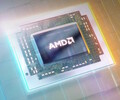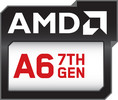Intel Pentium N4200 vs AMD A9-9420 vs AMD A6-9220e
Intel Pentium N4200
► remove from comparisonThe Intel Pentium N4200 is an Apollo Lake family, quad-core, ultra-low-power processor (SoC) that saw the light of day in 2016. Its four cores run at 1.1 GHz to 2.5 GHz, with only 2.4 GHz available when all the cores are fully loaded; there is no Hyper-Threading here and thus no additional threads. This chip has a fairly competent integrated graphics solution, the Intel HD Graphics 505, and eats very little (~6 W).
Curiously enough, Intel keeps making and selling the Pentium as of early 2023.
Architecture
Just like other Celeron N, Celeron J, Pentium N, Pentium J processors, this Pentium is notable for its small die size. It is easy to manufacture, lowering the costs and enabling Intel to compete with various ARM-based products such as the Raspberry Pi series.
The Pentium N4200 features the Goldmont CPU microarchitecture that came to replace Silvermont (2013), bringing with it several welcome improvements. There is still no L3 cache to be found here, however, it now takes less cycles to perform many operations, making for a double-digit IPC improvement.
The Pentium is compatible with DDR3L-1866, LPDDR3-1866, LPDDR4-2400 RAM. Intel's guidelines state that up to 8 GB are supported; that being said, various forum users report that the CPU functions just fine if mated to 16 GB and even 32 GB of RAM. The chip features six PCI-Express 2.0 lanes for connecting various devices, meaning a four-lane NVMe SSD will not be able to deliver a data transfer rate of more than 2 GB/s. eMMC and SATA storage is supported natively, too.
This Intel CPU is Secure Boot-compatible; technically, it will have no issue running 64-bit Windows 11. However, Microsoft only allows Windows 11 to be installed on systems with CPUs released in 2017 or later, making 64-bit Windows 10 the only OS that the Pentium is officially compatible with.
Last but not the least, please keep in mind that this is not a user-replaceable CPU. It gets permanently soldered to the motherboard (BGA1296 socket interface).
Performance
The average N4200 in our database competes with the Core i5-3339Y, a power efficient chip launched in 2013, as far as multi-thread benchmark scores are concerned, with the (much less ancient) Celeron 6305 lurking a little behind the two. In other words, the Pentium is a slow processor suitable for the most basic tasks only. As of 2021, it is light years behind the latest processors making use of high-performance architectures, such as the Zen 2-powered AMD Ryzen 3 5300U.
The Acer Aspire ES 17 ES1-732 is among the fastest laptops built around the N4200 that we know of. It can be around 50% faster than the slowest system featuring the same CPU in our database, depending on the circumstances.
Graphics
The HD Graphics 505 (18 EUs) is a rather good iGPU, considering this is a lower-end SoC released in 2016 we are talking about. As far as the feature set is concerned, the HD 505 is not much different from the HD Graphics 520 or any other graphics adapter that full-blown six-generation Intel Core i3/i5/i7 chips have. This iGPU is compatible with DX12; it will drive up to 3 monitors simultaneously at up to 2160p60. It will also happily decode VP9 and AVC, the two codecs that YouTube mostly relies on as of 2021.
The UHD Graphics runs at up to 750 MHz. Its actual clock speed will be much lower than that, since the small power budget has to be shared between the iGPU and the CPU cores. Expect most games to run terrible, even ones that were released in 2012 or 2010.
Power consumption
Just like most other N-class Intel processors, the Pentium N4200 has a default TDP of 6 W (also known as the Power Limit 1), making it a great option for passively cooled systems. Increasing the PL1 by just one or two watts, which many systems built around Apollo Lake allow one to do, improves the chip's performance by a huge margin, speaking subjectively.
This Pentium is built with a 14 nm Intel process making for poor energy efficiency (considering 14 nm processes are really old as of mid 2022).
AMD A9-9420
► remove from comparison
The AMD A9-9420 is an entry-level chip from the Stoney-Ridge APU series for notebooks (7th APU generation), which was announced mid 2016. At its launch, the A9-9420 is the fastest Stoney Ridge processor (dual-core version of Bristol Ridge) and takes over that place from the A9-9410 (-100 MHz CPU clock). It integrates two CPU cores (one Excavator module with 2 integer and on FP unit) clocked between 3 - 3.6 GHz. It also includes a Radeon R5 GPU with 192 shaders at 800 MHz as well as a single-channel DDR4-2133 memory controller, H.265 video engine and chipset with all I/O ports.
Architecture
Stoney Ridge is the successor of the Carrizo architecture and the design is almost identical. Thanks to optimized manufacturing processes and more aggressive Boost behavior, however, the clocks are a bit higher at the same power consumption. The memory controller now also supports DDR4-RAM, in this case up to 2133 MHz. Stoney Ridge is the designation for the smaller dual-core and single-core chip, while Bristol Ridge is the bigger quad-core chip with dual-channel memory controller. More technical details are available in the following articles:
Performance
Thanks to the high maximum clock of up to 3.6 GHz, the single-core performance should be pretty good. The multi-core performance on the other hand is much lower compared to the Bristol Ridge models. Compared to older Carrizo-L/Beema quad-cores, the APU should still perform pretty well. The level of performance should be similar to a Core-m3 and therefore also be sufficient for more demanding applications.
The TDP can be configured between 10-25 Watts, so there can be big performance differences under sustained workloads.
Graphics Card
The integrated Radeon R5 (Stoney Ridge) GPU has 192 active shader units (3 compute cores) clocked at up to 800 MHz. More details about the GPU are available in the linked articles above.
Power Consumption
AMD specifies the TDP of the A9-9420 with 15 Watts, but it can be configured between 10-25 Watts. This means the CPU is a good choice for thin and light notebooks, but also 15-inch devices with better cooling capabilities.
AMD A6-9220e
► remove from comparison
The AMD A6-9220e is an entry-level chip from the Stoney-Ridge APU series for notebooks (7th APU generation), which was announced mid 2017. The 9220e is an entry-level Stoney Ridge processor (dual-core version of Bristol Ridge) and integrates two CPU cores (one Excavator module with 2 integer and on FP unit) clocked between 1.6 - 2.4 GHz. It also includes a Radeon R4 GPU, probably with 192 shaders at 600 MHz, as well as a single-channel DDR4-2133 memory controller, H.265 video engine and chipset with all I/O ports. Compared to the similar named A6-9220 the 9220e is significantly slower clocked (2.5 - 2.9 GHz) including the GPU (600 versus 655 MHz) and can be passively cooled thanks to the TDP of 6W.
Architecture
Stoney Ridge is the successor of the Carrizo architecture and the design is almost identical. Thanks to optimized manufacturing processes and more aggressive Boost behavior, however, the clocks are a bit higher at the same power consumption. The memory controller now also supports DDR4-RAM, in this case up to 2133 MHz. Stoney Ridge is the designation for the smaller dual-core and single-core chip, while Bristol Ridge is the bigger quad-core chip with dual-channel memory controller. More technical details are available in the following articles:
Performance
Because of the significantly lower clock speed, the A6-9220e is noticeably slower than the A6-9220. In the Cinebench R15 Multi benchmark the 9220 reaches 38% higher scores, in the single thread test its more than twice as fast (219% versus the 9220 in the HP 255 G6). Compared to Intel CPUs, the A6-9220e is on par with the old Celeron N2820 in Cinebench (single and multi core). Therefore, the CPU is placed in the lowest segment (performance wise) and only suited for light tasks and light multitasking.
Graphics Card
The integrated Radeon R4 (Stoney Ridge) GPU is probably similar to the R5 with 192 active shader units (3 compute cores), but a reduced clock of just 655 instead of 800 MHz. More details about the GPU are available in the linked articles above.
Power Consumption
AMD specifies the TDP of the A6-9220e with 6 Watts and therefore significantly below the 15 W of the A6-9220. This means the APU can be passively cooled and is a good choice for thin and light notebooks.
| Model | Intel Pentium N4200 | AMD A9-9420 | AMD A6-9220e | ||||||||||||||||||||||||||||||||||||||||||||||||||||||||||||||||||||||||||||||||||||||||||||||||||||||||
| Series | Intel Pentium | AMD Bristol Ridge | AMD Bristol Ridge | ||||||||||||||||||||||||||||||||||||||||||||||||||||||||||||||||||||||||||||||||||||||||||||||||||||||||
| Codename | Apollo Lake | Stoney Ridge | Stoney Ridge | ||||||||||||||||||||||||||||||||||||||||||||||||||||||||||||||||||||||||||||||||||||||||||||||||||||||||
| Clock | 1100 - 2500 MHz | 3000 - 3600 MHz | 1600 - 2400 MHz | ||||||||||||||||||||||||||||||||||||||||||||||||||||||||||||||||||||||||||||||||||||||||||||||||||||||||
| L2 Cache | 2 MB | 1 MB | 1 MB | ||||||||||||||||||||||||||||||||||||||||||||||||||||||||||||||||||||||||||||||||||||||||||||||||||||||||
| Cores / Threads | 4 / 4 | 2 / 2 | 2 / 2 | ||||||||||||||||||||||||||||||||||||||||||||||||||||||||||||||||||||||||||||||||||||||||||||||||||||||||
| TDP | 6 Watt | 10-25 Watt | 6 Watt | ||||||||||||||||||||||||||||||||||||||||||||||||||||||||||||||||||||||||||||||||||||||||||||||||||||||||
| Technology | 14 nm | 28 nm | 28 nm | ||||||||||||||||||||||||||||||||||||||||||||||||||||||||||||||||||||||||||||||||||||||||||||||||||||||||
| max. Temp. | 105 °C | 90 °C | 90 °C | ||||||||||||||||||||||||||||||||||||||||||||||||||||||||||||||||||||||||||||||||||||||||||||||||||||||||
| Socket | BGA1296 | BGA | BGA | ||||||||||||||||||||||||||||||||||||||||||||||||||||||||||||||||||||||||||||||||||||||||||||||||||||||||
| Features | DDR3L-1866/LPDDR3-1866/LPDDR4-2400 RAM, PCIe 2, MMX, SSE, SSE2, SSE3, SSSE3, SSE4.1, SSE4.2, AES | Single-Channel DDR4-2133, Virtualization, | Single-Channel DDR4-2133, Virtualization, | ||||||||||||||||||||||||||||||||||||||||||||||||||||||||||||||||||||||||||||||||||||||||||||||||||||||||
| iGPU | Intel HD Graphics 505 (200 - 750 MHz) | AMD Radeon R5 (Stoney Ridge) ( - 800 MHz) | AMD Radeon R4 (Stoney Ridge) ( - 600 MHz) | ||||||||||||||||||||||||||||||||||||||||||||||||||||||||||||||||||||||||||||||||||||||||||||||||||||||||
| Architecture | x86 | x86 | x86 | ||||||||||||||||||||||||||||||||||||||||||||||||||||||||||||||||||||||||||||||||||||||||||||||||||||||||
| $161 U.S. | |||||||||||||||||||||||||||||||||||||||||||||||||||||||||||||||||||||||||||||||||||||||||||||||||||||||||||
| Announced | |||||||||||||||||||||||||||||||||||||||||||||||||||||||||||||||||||||||||||||||||||||||||||||||||||||||||||
| Manufacturer | ark.intel.com | ||||||||||||||||||||||||||||||||||||||||||||||||||||||||||||||||||||||||||||||||||||||||||||||||||||||||||
| Series: Bristol Ridge Stoney Ridge |
|
| |||||||||||||||||||||||||||||||||||||||||||||||||||||||||||||||||||||||||||||||||||||||||||||||||||||||||
| Transistors | 1200 Million | 1200 Million | |||||||||||||||||||||||||||||||||||||||||||||||||||||||||||||||||||||||||||||||||||||||||||||||||||||||||
| Die Size | 124.5 mm2 | 124.5 mm2 | |||||||||||||||||||||||||||||||||||||||||||||||||||||||||||||||||||||||||||||||||||||||||||||||||||||||||
| L1 Cache | 160 KB |


 Deutsch
Deutsch English
English Español
Español Français
Français Italiano
Italiano Nederlands
Nederlands Polski
Polski Português
Português Русский
Русский Türkçe
Türkçe Svenska
Svenska Chinese
Chinese Magyar
Magyar
